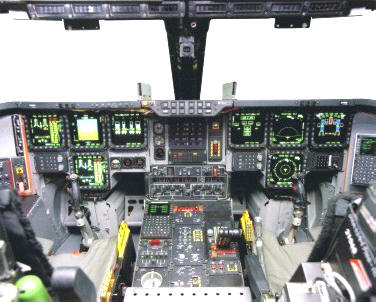

Payload: 40,000 pounds (18,144 kilograms)Īrmament: conventional or nuclear weapons Power plant: four General Electric F118-GE-100 engines and Contractor Team: Boeing Military Airplanes Co., Hughes Radar Systems Group, General Electric Aircraft Engine Group and Vought Aircraft Industries, Inc. Primary function: multi-role heavy bomberĬontractor: Northrop Grumman Corp. Boeing Military Airplanes Co., Hughes Radar Systems Group, General Electric Aircraft Engine Group and Vought Aircraft Industries, Inc., are key members of the aircraft contractor team.

The prime contractor, responsible for overall system design and integration, is Northrop Grumman Integrated Systems Sector. 1, 2009, the Air Force's newest command, Air Force Global Strike Command, assumed responsibility for the B-2 from Air Combat Command.
#Cockpit b2 full#
The aircraft received full operational capability status in December 2003. The B-2 completed its first-ever combat deployment in support of Operation Iraqi Freedom, flying 22 sorties from a forward operating location as well as 27 sorties from Whiteman AFB and releasing more than 1.5 million pounds of munitions. In support of Operation Enduring Freedom, the B-2 flew one of its longest missions to date from Whiteman to Afghanistan and back. The combat effectiveness of the B-2 was proved in Operation Allied Force, where it was responsible for destroying 33 percent of all Serbian targets in the first eight weeks, by flying nonstop to Kosovo from its home base in Missouri and back. Depot maintenance responsibility for the B-2 is performed by Air Force contractor support and is managed at the Oklahoma City Air Logistics Center at Tinker AFB, Okla. The first aircraft, Spirit of Missouri, was delivered Dec. Whiteman AFB, Missouri, is the only operational base for the B-2. The B-2 Combined Test Force, Air Force Flight Test Center, Edwards Air Force Base, California, is responsible for flight testing the engineering, manufacturing and development aircraft on the B-2. 22, 1988, when it was rolled out of its hangar at Air Force Plant 42, Palmdale, California. The first B-2 was publicly displayed on Nov. The B-2 has a crew of two pilots, a pilot in the left seat and mission commander in the right, compared to the B-1B's crew of four and the B-52's crew of five. Many aspects of the low-observability process remain classified however, the B-2's composite materials, special coatings and flying-wing design all contribute to its "stealthiness." These signatures make it difficult for the sophisticated defensive systems to detect, track and engage the B-2. The B-2's low observability is derived from a combination of reduced infrared, acoustic, electromagnetic, visual and radar signatures. Its unrefueled range is approximately 6,000 nautical miles (9,600 kilometers). Its low-observability provides it greater freedom of action at high altitudes, thus increasing its range and a better field of view for the aircraft's sensors. The revolutionary blending of low-observable technologies with high aerodynamic efficiency and large payload gives the B-2 important advantages over existing bombers. Its capability to penetrate air defenses and threaten effective retaliation provides a strong, effective deterrent and combat force well into the 21st century. Its low-observable, or "stealth," characteristics give it the unique ability to penetrate an enemy's most sophisticated defenses and threaten its most valued, and heavily defended, targets. The B-2 provides the penetrating flexibility and effectiveness inherent in manned bombers. The B-2 brings massive firepower to bear, in a short time, anywhere on the globe through previously impenetrable defenses. A dramatic leap forward in technology, the bomber represents a major milestone in the U.S. The B-2 Spirit is a multi-role bomber capable of delivering both conventional and nuclear munitions.


 0 kommentar(er)
0 kommentar(er)
